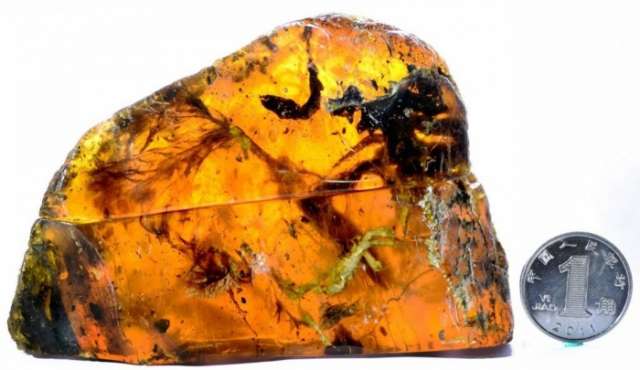The chick died young and fell into a pool of sap. It died halfway through its first feather molt, suggesting that the animal broke out of its egg just a few days before it perished. Its life began in the moist tropics beneath conifer trees. It ended near a puddle of conifer gunk, called resin, which fossilized into amber. Burmese diggers uncovered the amber 99 million years later.
“Enantiornithines are close relatives to modern birds, and in general, they would have looked very similar. However, this group of birds still had teeth and claws on their wings,” said Ryan McKellar, a paleontologist at Canada's Royal Saskatchewan Museum. This animal lived during the Cretaceous Period, which came to a cataclysmic close 65.5 million years ago and took the non-bird dinosaurs with it.
The enantiornithes, due to their distinct hip and ankle bones, may have flown differently than modern birds. But they were capable fliers. (If you are wondering whether this bird relative was more bird or winged dinosaur, well, consider it both: Birds are avian dinosaurs, after all.)
Entombed in amber were details as fine as the hatchling's eyelid and the outer opening of its ear. The resin recorded no sign of a struggle. “The hatchling may have been dead by the time it entered” the resin pool, McKellar said. “One of the leg bones has been dragged away from its natural position, suggesting that the corpse may have been scavenged before it was covered by the next flow of resin.”
Evidence suggests that enantiornithes received little in the way of parental care, unlike more doting modern birds. The ancient chicks, born on the ground, had to scamper into trees to avoid being eaten. Scampering enantiornithes got stuck in resin fairly frequently, McKellar said, though this fossil is far more comprehensive than typical specimens.
Its 99-million-year-old claws appear almost as detailed as chicken feet you'd find in a supermarket. The foot, presumed at first to be a lizard's by the amber miner who found it, was covered in golden scales and just under an inch long. “The preserved skin surface allows us to observe the feet in great detail,” McKellar said.
The resin trapped one of the bird's wings as well. Despite its young age, the animal already had brown flight feathers on its wings. McKellar said it also had “a sparse coat of fluffy pale or white feathers across most of its belly, legs, and tail.”
McKellar and his colleagues probed the fossil using several types of imaging technology, including light microscopes and X-ray micro-CT scanning. The researchers discovered that the feathers on the enantiornithes' wings were quite similar to modern bird feathers. But its tail and legs were covered by what McKellar described as tufts similar to “proto-feathers” or “dino-fuzz.”
Recent amber discoveries offer strikingly detailed, if orange-tinted, windows into ancient worlds. Sap trapped not only birds but lizards, bugs and bits of non-bird dinosaurs, too. In December, McKellar and his colleagues announced they'd found a dinosaur tail trapped in amber also excavated from a mine in Burma (also known as Myanmar).
But amber containing dino DNA, as popularized by “Jurassic Park” and its ancient mosquitoes swollen with dinosaur blood, appears to be remain in the realm of science fiction. “Unfortunately, DNA seems to be ‘off the menu’ for specimens such as this one,” McKellar said. “To the best of our current understanding, DNA has a half-life of around 500 years and cannot be recovered in meaningful quantities from amber pieces that are more than a few million years old.”
That doesn't mean amber completely erases prehistoric biochemistry. The scientists have teased iron from the toothed bird, trapped in carbon in the hatchling's soft tissues, possibly from its blood. Further research may uncover proteins from the bird's feathers, McKellar said, allowing experts to home in on the colors of the animal's brown plumage.
More about:
















































